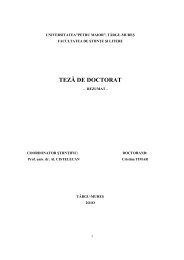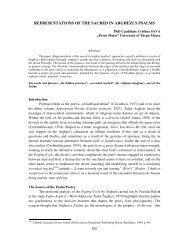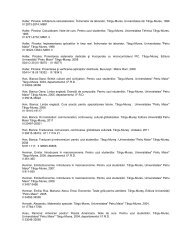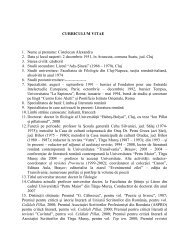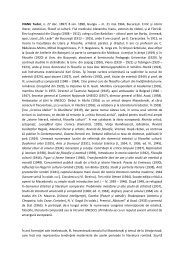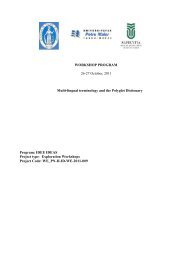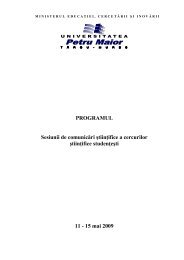The concept of self in virginia woolf's mrs - Universitatea"Petru Maior"
The concept of self in virginia woolf's mrs - Universitatea"Petru Maior"
The concept of self in virginia woolf's mrs - Universitatea"Petru Maior"
Create successful ePaper yourself
Turn your PDF publications into a flip-book with our unique Google optimized e-Paper software.
sat <strong>in</strong> her draw<strong>in</strong>g-room and made a meet<strong>in</strong>g-po<strong>in</strong>t, a radiancy no doubt <strong>in</strong> some dull lives, a refuge for the<br />
lonely to come to, perhaps. (MD, 42)<br />
• the act <strong>of</strong> creation<br />
In both life and art, Virg<strong>in</strong>ia Woolf perceives the act <strong>of</strong> creation as a means <strong>of</strong> defy<strong>in</strong>g<br />
madness and cop<strong>in</strong>g with reality. In Mrs Dalloway, creation and communication are brought<br />
together, both <strong>in</strong> connection with the soundness <strong>of</strong> m<strong>in</strong>d, the ability <strong>of</strong> dist<strong>in</strong>guish<strong>in</strong>g the real<br />
from the unreal, <strong>of</strong> “hav<strong>in</strong>g a sense <strong>of</strong> proportions”. <strong>The</strong>refore, analysed from the perspective<br />
<strong>of</strong> one’s search for <strong>self</strong>hood, writ<strong>in</strong>g becomes (to Virg<strong>in</strong>ia Woolf) a def<strong>in</strong><strong>in</strong>g way <strong>of</strong> creat<strong>in</strong>g<br />
and shar<strong>in</strong>g, <strong>of</strong> re-analys<strong>in</strong>g and com<strong>in</strong>g to terms with the past. And aga<strong>in</strong>: “It is this writ<strong>in</strong>g<br />
that gives me my proportions”.<br />
Follow<strong>in</strong>g the same analysis, the very idea <strong>of</strong> party-giv<strong>in</strong>g implies for Clarissa<br />
Dalloway creat<strong>in</strong>g and shar<strong>in</strong>g reality (Ruotolo, 115), an attempt to communicate <strong>in</strong> fact,<br />
perceived as a means <strong>of</strong> survival. Hawthorn (1975: 37) adds a very <strong>in</strong>terest<strong>in</strong>g approach here,<br />
stat<strong>in</strong>g that parties <strong>in</strong>volve vulnerability, risk and an <strong>of</strong>fer<strong>in</strong>g, enabl<strong>in</strong>g Clarissa to “regenarate<br />
her sense <strong>of</strong> identity through the development <strong>of</strong> relationships based on openness and<br />
honesty”.<br />
Septimus Warren Smith, writes notes which he refuses to share (they have to be<br />
hidden or destroyed). In his case the act <strong>of</strong> writ<strong>in</strong>g is not meant to communicate, it represents<br />
the failure to create a bond that would tie together the <strong>in</strong>dividual and the others, but at the<br />
same time, it represents the <strong>in</strong>dividual’s attempt to preserve the <strong>self</strong> unspoiled by the others.<br />
Another element worth mention<strong>in</strong>g here is the hat that his wife creates, Septimus eventually<br />
tak<strong>in</strong>g part <strong>in</strong> this process <strong>of</strong> artistic creation. <strong>The</strong> hat that is to be given as a present<br />
symbolizes an act <strong>of</strong> <strong>of</strong>fer<strong>in</strong>g, shar<strong>in</strong>g, communicat<strong>in</strong>g, signal<strong>in</strong>g his com<strong>in</strong>g back to reality,<br />
to sanity, Septimus gradually allow<strong>in</strong>g him<strong>self</strong> to rediscover/see (on open<strong>in</strong>g his eyes) the<br />
real. But communication fails aga<strong>in</strong> as dr Holmes (“the human nature”) corners him; it is<br />
precisely this feel<strong>in</strong>g <strong>of</strong> be<strong>in</strong>g trapped that makes him commit suicide (although “life was<br />
good”, as he says to him<strong>self</strong> right before throw<strong>in</strong>g him<strong>self</strong> out <strong>of</strong> the w<strong>in</strong>dow).<br />
Accord<strong>in</strong>g to Julia Briggs (2005:146) “Septimus’s experiences are the only record we<br />
have <strong>of</strong> what Woolf’s illness felt like from the <strong>in</strong>side”, echo<strong>in</strong>g “moments from her earlier<br />
fiction”. <strong>The</strong>refore writ<strong>in</strong>g about this character’s madness means <strong>in</strong> fact rewrit<strong>in</strong>g madness, as<br />
Briggs states, and (to some extent) re-liv<strong>in</strong>g/re-experienc<strong>in</strong>g this traumatic part <strong>of</strong> the<br />
novelist’s personal history. Character creation emerges as a reflection/representation <strong>of</strong> one’s<br />
<strong>self</strong>.<br />
F<strong>in</strong>ally Clarissa imag<strong>in</strong>es Septimus’s suicide as an attempt to communicate: “Death<br />
was defiance. Death was an attempt to communicate, people feel<strong>in</strong>g the impossibility <strong>of</strong><br />
694



